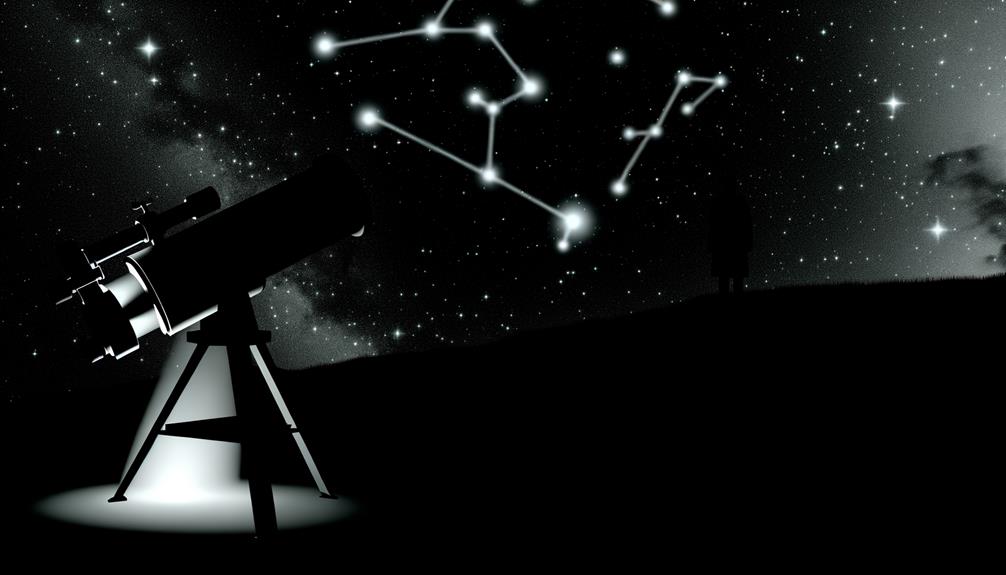Like Galileo peering through his telescope, you’re about to embark on a journey into the cosmos. The night sky, with its glittering constellations and swirling galaxies, holds a mesmerizing beauty that’s been captivating humans for millennia.
You’ll need a basic understanding of astronomy, the right equipment, and a keen eye to fully appreciate its wonders. But don’t worry, this exploration won’t require a spaceship – just your curiosity.
Ready to discover the mysteries that lie beyond the earth’s atmosphere?
Understanding basic astronomy
To truly appreciate the wonders of stargazing, you’ll first need to grasp the basics of astronomy. Don’t worry, it’s not as daunting as it sounds. The key is to start small and build your knowledge gradually.
First, familiarize yourself with the celestial sphere. Imagine you’re standing inside a giant globe, with the earth at the center. The globe’s inner surface represents the sky. All stars, planets, and other celestial objects appear to us as if projected onto this sphere.
Next, learn about the ecliptic, the path the sun appears to trace across the sky. It’s important because the moon and planets move near it. Understanding the ecliptic will help you predict where these objects will appear.
Then, you’ll need to comprehend the concept of celestial coordinates. Much like longitude and latitude on Earth, these coordinates help pinpoint locations in the sky. The two main ones are right ascension and declination.
Lastly, get a handle on the different types of celestial bodies – stars, planets, galaxies, and nebulae. Recognizing these can enrich your stargazing experience.
Essential stargazing equipment
Now that you’ve got the basics of astronomy down, let’s gear up and explore the essential equipment you’ll need for the best stargazing experience.
First, you can’t go wrong with a good telescope. It’s the fundamental tool for observing the night sky in detail. There’s a range to choose from, so consider your budget and needs. Refractor telescopes are perfect for beginners, offering clear images for viewing planets and the moon. On the other hand, reflector telescopes, although a bit pricier, provide stunning views of galaxies and nebulae.
Next, binoculars can be a great asset, especially if you’re just getting started or if you’re on the move. They’re portable, easy to use, and perfect for viewing large sky areas and locating objects.
Lastly, don’t forget a star chart or sky map app on your smartphone. These tools can guide you around the night sky, helping you pinpoint heavenly objects. Remember, the key is to be comfortable, so bring a reclining lawn chair, warm clothes, and a red flashlight to preserve your night vision. With the right gear, you’re set for a stellar journey.
Identifying key constellations
Once you’ve gathered your stargazing gear, the next exciting step is learning to identify key constellations in the night sky. Familiar constellations like Ursa Major, Orion, and Cassiopeia are an excellent place to start.
You’ve likely heard of Ursa Major, also known as the Great Bear. It’s a large, easily recognizable constellation that includes the famous ‘Big Dipper’. It’s your gateway to finding Polaris, the North Star, which is part of the smaller constellation, Ursa Minor.
Orion, the Hunter, is another favorite among stargazers. You can’t miss Orion’s Belt, a straight line of three bright stars. Just south of the belt, you’ll see a bright, fuzzy spot. That’s Orion Nebula, a stellar nursery where stars are born.
Cassiopeia, the Queen, is recognized by its distinct ‘W’ shape. It’s nearly circumpolar, meaning it’s visible all year round from most locations in the Northern Hemisphere.
Best locations for stargazing
Choosing the right spot for stargazing can significantly enhance your celestial viewing experience. You’re looking for locations with minimal light pollution, as city lights can drown out the stars. Rural areas, particularly those at higher elevations, often offer the best views.
National parks are excellent options, they’re usually far from urban light pollution. Places like Death Valley National Park in the U.S., or the Aoraki Mackenzie Dark Sky Reserve in New Zealand, are renowned for their starry vistas.
Your own backyard can also be a great spot, provided you live in a less populated area and can turn off all surrounding lights. You’d be amazed at what you can see when you’re truly in the dark.
If you’re up for a journey, consider a trip to Mauna Kea Observatories in Hawaii. It’s one of the world’s premier astronomical research sites. At over 13,000 feet, you’re above much of the atmosphere’s water vapor, providing exceptionally clear views.
Observing celestial events
When you’ve found that perfect stargazing spot, it’s time to turn your attention to the sky’s ever-changing events, which can offer a truly mesmerizing spectacle. Meteors blazing across the sky, eclipses casting dramatic shadows, or planets aligning can all be thrilling to witness.
You don’t need an expensive telescope to observe many of these celestial events. Your naked eyes can catch shooting stars during a meteor shower, and binoculars can give you a closer look at lunar eclipses or planetary conjunctions. It’s important to check a celestial calendar to know when these events are happening. There are plenty of resources online that can help you with this.
Conclusion
You’ve now got the basics down, from understanding astronomy to identifying constellations. With your new gear, you’re ready to hit those prime stargazing spots. Don’t forget, celestial events are the icing on the cake, helping you fully appreciate the wonders of the night sky. The stars are calling, so get out there and start exploring.
There’s a whole universe waiting for you to discover!










